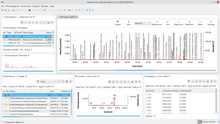Pyrolysis–gas chromatography–mass spectrometry
| Acronym | PyGCMS |
|---|---|
| Classification | Mass spectrometry |
| Analytes | polymers biomolecules paint |
| Other techniques | |
| Related | gas chromatography |

Pyrolysis–gas chromatography–mass spectrometry is a method of chemical analysis in which the sample is heated to decomposition to produce smaller molecules that are separated by gas chromatography and detected using mass spectrometry.[1][2]
How it works
[edit]Pyrolysis is the thermal decomposition of materials in an inert atmosphere or a vacuum. The sample is put into direct contact with a platinum wire, or placed in a quartz sample tube, and rapidly heated to 600–1000 °C. Depending on the application even higher temperatures are used. Three different heating techniques are used in actual pyrolyzers: Isothermal furnace, inductive heating (Curie Point filament), and resistive heating using platinum filaments. Large molecules cleave at their weakest bonds, producing smaller, more volatile fragments. These fragments can be separated by gas chromatography. Pyrolysis GC chromatograms are typically complex because a wide range of different decomposition products is formed. The data can either be used as fingerprint to prove material identity or the GC/MS data is used to identify individual fragments to obtain structural information.
To increase the volatility of polar fragments, various methylating reagents can be added to a sample before pyrolysis.[3]
Besides the usage of dedicated pyrolyzers, pyrolysis GC of solid and liquid samples can be performed directly inside programmable temperature vaporizer (PTV) injectors that provide quick heating (up to 60 °C/s) and high maximum temperatures of 600-650 °C. This is sufficient for many pyrolysis applications. The main advantage is that no dedicated instrument has to be purchased and pyrolysis can be performed as part of routine GC analysis. In this case quartz GC inlet liners can be used. Quantitative data can be acquired, and good results of derivatization inside the PTV injector are published as well.[4][5]
Applications
[edit]Pyrolysis gas chromatography is useful for the identification of involatile compounds.[6] These materials include polymeric materials, such as acrylics or alkyds.[7] The way in which the polymer fragments, before it is separated in the GC, can help in identification. Pyrolysis gas chromatography is also used for environmental samples,[8] including fossils.[9] Pyrolysis GC is used in forensic laboratories to analyze evidence found in crime scenes such as paints, adhesives, plastics, synthetic fibres and soil extracts.[10]
References
[edit]- ^ Goodacre, R.; Kell, D. B. (1996). "Pyrolysis mass spectrometry and its applications in biotechnology". Curr. Opin. Biotechnol. 7 (1): 20–28. doi:10.1016/S0958-1669(96)80090-5. PMID 8791308.
- ^ Peacock, P. M.; McEwen, C. N. (2006). "Mass Spectrometry of Synthetic Polymers. Anal. Chem". Analytical Chemistry. 78 (12): 3957–3964. doi:10.1021/ac0606249. PMID 16771534.
- ^ Halket JM, Zaikin VG (2006). "Derivatization in mass spectrometry --7. On-line derivatisation/degradation". European Journal of Mass Spectrometry. 12 (1): 1–13. doi:10.1255/ejms.785. PMID 16531644. S2CID 36931671.
- ^ Erwin R. Kaal; Mitsuhiro Kurano; Margit Geißler; Hans-Gerd Janssen (2008). "Hyphenation of aqueous liquid chromatography to pyrolysis-gas chromatography and mass spectrometry for the comprehensive characterization of water-soluble polymers". Journal of Chromatography A. 1186 (1–2): 222–227. doi:10.1016/j.chroma.2007.10.035. PMID 17988672.
- ^ Eckerle, P.; Pursch, M.; Cortes, H. J.; Sun, K.; Winniford, B. & Luong, J. (2008). "Determination of short-chain branching content in polyethylene by pyrolysis comprehensive multidimensional gas chromatography using low thermal mass column technology". Journal of Separation Science. 31 (1): 3416–3422. doi:10.1002/jssc.200800218. PMID 18798214.
- ^ Hans-Joachim Hübschmann (27 July 2015). Handbook of GC-MS: Fundamentals and Applications. John Wiley & Sons. pp. 68–. ISBN 978-3-527-33474-2.
- ^ "National Gallery of Art Conservation: Scientific Research". Archived from the original on 2007-09-16. Retrieved 2007-08-21.
- ^ Janos P (2003). "Separation methods in the chemistry of humic substances". Journal of Chromatography A. 983 (1–2): 1–18. doi:10.1016/S0021-9673(02)01687-4. PMID 12568366.
- ^ Poinar HN (2002). "The genetic secrets some fossils hold". Acc. Chem. Res. 35 (8): 676–84. doi:10.1021/ar000207x. PMID 12186573.
- ^ Wheals, B. B.; Noble, W. (1972-09-01). "Forensic applications of pyrolysis gas chromatography". Chromatographia. 5 (9): 553–557. doi:10.1007/BF02277631. ISSN 1612-1112. S2CID 102208189.
